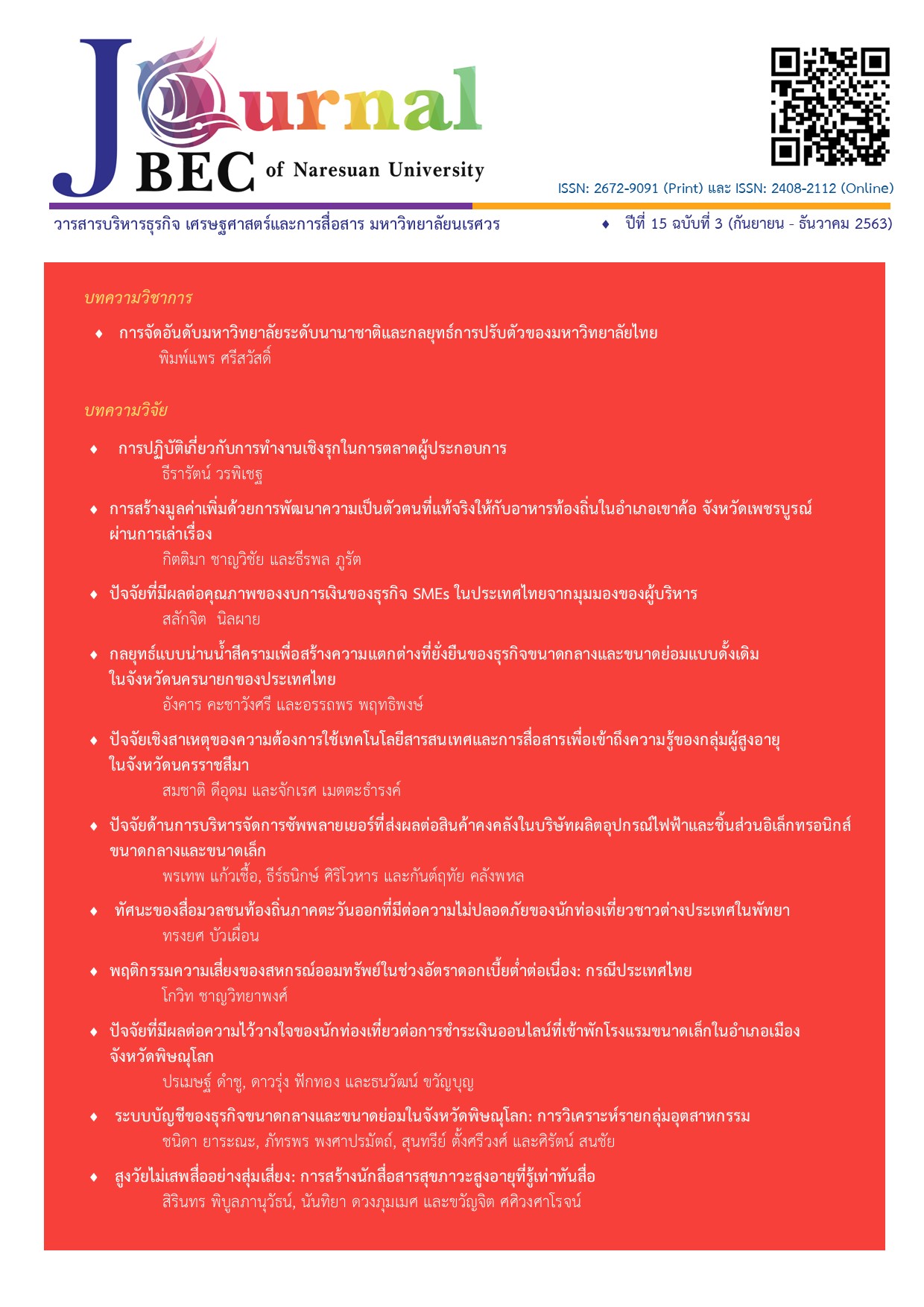The Causal Factors of Information Technology Requirements and Communications for Accessing to Knowledge for the Elderly in Nakhon Ratchasima Province
Main Article Content
Abstract
This research has objectives 1) to develop the causal relation model of factor and 2) to study the direct and indirect influences of the causal factors of information technology requirements and communications affecting the access to knowledge for the elderly in Nakhon Ratchasima Province. The sample of the research is 400 elderly people. The researcher used a questionnaire as a research instrument and was analyzed by the structural equation model. The result found that the mentioned causal factors consisted of health, work, public participation and knowledge accessibility. The result of model development found that the developed model conformed with empirical data by having the Goodness of fit index (GFI) at X2=77.141, dƒ=31, X2/dƒ=2.488, RMSEA=0.059, CFI=0.983, TLI=0.970, SRMR=0.030. Furthermore, the result of the study on direct and indirect influences found that the health factor significant influenced directly to the knowledge accessibility of the elderly in Nakhon Ratchasima Province. On the other hand, the public participation factor influenced indirectly through working.
Article Details
References
Chotjirawatthana, S., Tantrarungroj, P., and Suwanmonkma, S. (2019). The needs assessment of informtion and communication technology to support health literacy in thh learning center for the elderly in bangkok and its vincinities. Journal of Library and Information Science srinakharinwirot University. 12(2), 71-85.
Chotjirawwatthana, L., Promjaisa, N., Kaewsri, P., and Jaiboontan, T. (2019). The mobilizational of social networks in creating perception and benefits accessibility for poor elderly in urban communities of Chiang Rai province. Kasalongkham Research Journal, 12(2), 15-27.
Cohen, J. M., and Uphoff, N. T. (1977). Rural development participation: Concept and Measure for project design implementation and evaluation. Cornell: Rural Development Committee Center for international Studies. Cornell University. 7-111.
Department of Older person. (2014). Aging policy. Ministry of Social Development and Human Security.
Dhamsiri, B. (2006). Family and caring for the elderly. Karavak Journal, Issue of the prince’s day exhibition. Faculty of Science and Technology. Valaya-alongkorn Rajabhat University.
Diamantopoulos, A., and Siguaw, A. D. (2000). Introducing LISREL: A guide for the uninitiated. Sage Publications, London.
Disank, C. (2016). Sufficiency economy in the area of Nong Kin Phen Sub-district administrative organization, Warin Chamrab Sub-district, Ubon Ratchathani Province. Journal of Liberal Arts, Ubon Ratchathani University, 12(1), 265-283.
Eakpachaisawad, T. (2015). Factors affecting the elderly in the community Phetchabun, mueang district, Phetchabun province. Dhonburi Rajabhat University Journal, 9(1), 92-104.
Foundation of Thai Gerontology Research and Development institute. (2015). Situation of the Thai elderly 2015. Retrieved January 8, 2020, from http://thaitgri.org/?p=37841
George, D. and Mallery, M. (2010). SPSS for Windows Step by Step: A Simple Guide and Reference, 17.0 Update, 10th Edition, Pearson, Boston.
Hair, J. F., Black, W. C., Babin, B. J., Anderson, R. E., and Tatham, R. L. (2006). Multivariate data analysis. 6th ed. Upper Saddle River, NJ: Prentice Hall.
Hair, J. F., Jr, Anderson, R. E., Tatham, R. L., and Black, W. C. (1995). Multivariate Data Analysis. 3rd ed. New York: Macmillan.
Hu, L. T., and Bentler, P. M. (1955). Cutoff criteria for fit index in covariance structural analysis: conventional criteria versus new alternations. Structural Equation Modeling: A Multidisciplinary Journal, 6, 1-55.
Janobrom, S. (1998). Elderly vision and informal education for Thai elderly. Bangkok: Chulalongkorn University.
Jin, B. (2018). Older adults’ informal learning using mobile devices: A review of the literature. In Adult Education Research Conference 2018 (pp. 1-21). Retrieved February 22, 2020, from http://newprairiepress.org/aerc/2018/papers/32
Joreskog, K. G., and Sorborn, D. (1989). Advance in fact or analysis and structural equation models. Cambridge, MA: Abt books.
Kaplan, D. (2000). Structural equation modeling: Foundations and extensions. Thousand Oaks, CA: Sage.
Kickbusch, I. S. (2001). Health literacy: Addressing the health and education divide. Health Promotion International, 16(3), 289-297.
Krea-ngam, W. (2018). Special lecture: Administration and development of government human resources for sustainable country reform. Civil Service e-Journal, 61(4), 3-8.
Mendard, S. (1995). Applied Logistic Regression Analysis: Sage University Series on Quantitative Applications in the Social Sciences. Thousand Oaks, CA: Sage.
Ministry of Information and Communication Technology. (2010). Draft of information and communication technology policy for term 2011-2020. Retrieved February 22, 2020, from http://www.ict2020.in.th/?q=system/files/u1/ICT2020_strategies_ for_PH.pdf
National Committee for the Elderly. (2010). Phan phu sung-ayu thai chabap thi 2 (phuthasakkarat 2545-2565) [2nd National plan for older persons (B.E. 2545-2565)] 1st Revised Edition B.E. 2552. Bangkok: Ministry of Social Development and Human Security.
National Health Security Office. (2561). Strategic plan for system operations long-term care for the elderly in dependency 2014-2018. Bangkok: National Health Security Office.
Nunnally, J. C. (1978). Psychometric Theory. New York: McGraw-Hill.
Office of the Education Council (2018). Comparative research report for policy development on learning promotion of the elderly in Thailand. Bangkok: Author.
Oswald, T., and Cotton, S. (2015). Tablets can help elderly cross the ‘digital divide’.Retrieved february 22, 2020, from http://msutoday.msu.edu/news/2015/ tablets-can-help-elderly-cross-the-digital-divide/
Pallant, J. (2010). SPSS Survival Manual: A Step by Step Guide to Data Analysis Using IBM SPSS 4th ed. Maidenhead: Open University: Press/McGraw-Hill.Pedhazur, E. J. (1997). Multiple regression in behavioral research. South Melbourne: Wadsworth.
Ratana-Ubol, A. (2019). Proposal for operational improvement regarding senior citizen’s potential enhancement. Silpakorn Educational Research Journal, 11(1), 26-46.
Sirisunhirun, S. (2016). Guidelines of community learning center for promoting lifelong learning in elderly. Governance Journal, 5(2), 59-74.
Tabachnick, B. G., and Fidell, L. S. (2011). Using Multivariate Statistics 4th ed. Boston, MA: Allyn and Bacon.
Tabachnick, B.G. and Fidell, L.S. (2013). Using Multivariate Statistics. Pearson, Boston.
Vanichyanukoh, D., Anantho, S., and Thongrin, S. (2017). The process of internet acceptance for developing the quality of life of senior citizens. Dhonburi Rajabhat University Journal, 11(2), 60-73.
World Health Organization (WHO). (2001). Health in Old: A guide to good health for senior citizens and their careers. (n.p.).
Zhang, J., and Umemuro, H. (2012). Older adults’ hedonic and eudaimonic well-being in information and communication technology activities. Gerontechnology 2012. 10(4) : 231-243.


